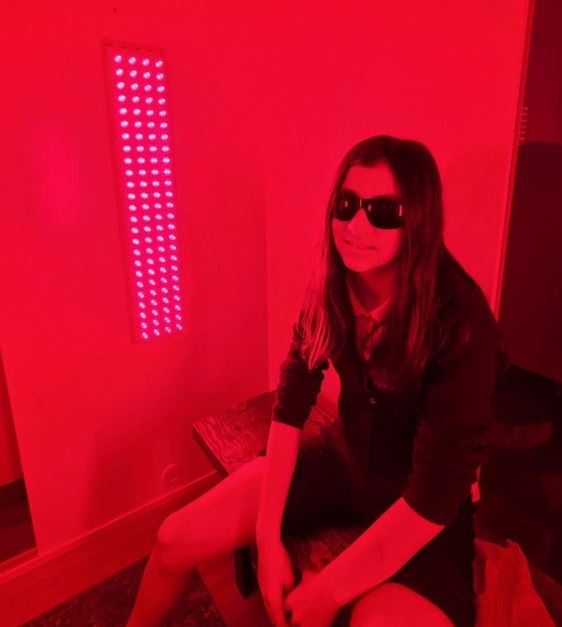![]() Free Shipping
Free Shipping ![]() Buy Now, Pay Later
Buy Now, Pay Later ![]() Eligible
Eligible
Red Light Therapy for Otosclerosis: A Promising Treatment Approach

Introduction
Otosclerosis is a progressive bone disorder that affects the middle ear, leading to hearing loss. It occurs when abnormal bone growth interferes with the movement of the stapes bone, preventing sound vibrations from reaching the inner ear effectively. Traditional treatments include hearing aids and surgical interventions like stapedectomy. However, emerging research suggests that red light therapy (RLT), also known as low-level laser therapy (LLLT), may offer a non-invasive alternative to help manage otosclerosis symptoms.
This article explores the science behind red light therapy, its potential benefits for otosclerosis, clinical evidence, and practical considerations for patients seeking alternative treatments.
Understanding Otosclerosis
What is Otosclerosis?
Otosclerosis is a condition characterized by abnormal bone remodeling in the otic capsule (the bony structure surrounding the inner ear). This leads to the fixation of the stapes bone, impairing sound transmission.
Symptoms of Otosclerosis
- Progressive conductive hearing loss (most common)
- Tinnitus (ringing in the ears)
- Dizziness or balance issues (less common)
- Difficulty hearing low-frequency sounds
Current Treatment Options
- Hearing Aids – Amplify sound but do not stop disease progression.
- Sodium Fluoride Supplements – May slow bone remodeling but with limited efficacy.
- Stapedectomy Surgery – Replaces the stapes with a prosthesis to restore hearing.
While these treatments can be effective, they come with risks and limitations. This has led researchers to explore red light therapy as a potential adjunct or alternative treatment.
VELLGUS Elite V2
THE #1 RATED RED LIGHT DEVICE
VELLGUS pro V2
THE #1 RATED FULL BODY RED LIGHT DEVICE
What is Red Light Therapy (RLT)?
Red light therapy is a form of photobiomodulation (PBM) that uses low-wavelength red and near-infrared (NIR) light to stimulate cellular repair and reduce inflammation.
How Does Red Light Therapy Work?
- Penetrates skin and tissues (up to 5-10 mm depth).
- Enhances mitochondrial function by boosting adenosine triphosphate (ATP) production.
- Reduces inflammation by modulating cytokines.
- Promotes tissue repair by increasing collagen synthesis.
Medical Applications of RLT
- Wound healing
- Pain relief (arthritis, neuropathy)
- Skin rejuvenation
- Neurological conditions
- Bone and cartilage repair
Given its anti-inflammatory and regenerative properties, researchers are now investigating RLT for otosclerosis.
Red Light Therapy for Otosclerosis: The Science
1. Bone Remodeling and Anti-Inflammatory Effects
Otosclerosis involves abnormal bone metabolism in the ear. Studies suggest that RLT can:
- Inhibit osteoclast activity (cells that break down bone).
- Promote osteoblast function (cells that build bone).
- Reduce inflammation in the otic capsule.
A 2018 study in Lasers in Medical Science found that LLLT reduced bone resorption and promoted bone regeneration in animal models, suggesting potential benefits for otosclerosis.
2. Improved Blood Circulation
RLT enhances microcirculation, which may help deliver more oxygen and nutrients to the inner ear, potentially slowing otosclerosis progression.
3. Protection Against Oxidative Stress
Oxidative stress contributes to hearing loss. RLT has been shown to:
- Increase antioxidant enzymes (e.g., superoxide dismutase).
- Reduce reactive oxygen species (ROS) that damage cochlear cells.
4. Potential Nerve Regeneration
Some research indicates RLT may support auditory nerve repair, which could benefit patients with sensorineural hearing loss secondary to otosclerosis.
Clinical Evidence Supporting RLT for Otosclerosis
While direct studies on RLT for otosclerosis are limited, related research is promising:
- A 2020 study in Hearing Research found that NIR light improved cochlear function in noise-induced hearing loss.
- A 2017 study in PLOS ONE showed that LLLT reduced inflammation in middle ear infections, suggesting potential for otosclerosis-related inflammation.
- A 2019 review in Biomedicine & Pharmacotherapy highlighted RLT’s role in bone regeneration, supporting its potential in otosclerosis.
More clinical trials are needed, but preliminary data is encouraging.
How to Use Red Light Therapy for Otosclerosis
1. Choosing the Right Device
- Wavelength: 600-850 nm (red to near-infrared).
- Power Density: 5-100 mW/cm² (low to moderate intensity).
- FDA-Cleared Devices: Consider brands like Joovv, Mito Red Light, or PlatinumLED.
2. Treatment Protocol
- Frequency: 3-5 sessions per week.
- Duration: 10-20 minutes per session.
- Placement: Direct light at the mastoid bone (behind the ear).
3. Safety Considerations
- Avoid looking directly into the light to protect eyes.
- Start with shorter sessions to assess tolerance.
- Consult a healthcare provider before starting, especially if you have photosensitivity conditions.
Potential Benefits of RLT for Otosclerosis Patients
- Non-Invasive & Painless – No surgery or medications needed.
- Reduces Inflammation – May slow abnormal bone growth.
- Improves Hearing Function – Possible enhancement of cochlear health.
- Minimal Side Effects – Unlike surgery, RLT has low risk.
Limitations and Future Research
- Lack of large-scale human trials specifically for otosclerosis.
- Optimal dosing not yet standardized – More research needed.
- Not a standalone cure – Best used alongside conventional treatments.
Future studies should explore:
- Long-term effects of RLT on otosclerosis progression.
- Combination therapies (e.g., RLT + sodium fluoride).
Conclusion
Red light therapy represents a promising, non-invasive approach to managing otosclerosis. While more research is needed, current evidence suggests that RLT may help reduce inflammation, improve bone remodeling, and protect auditory function.
Patients interested in RLT should consult an ENT specialist to integrate it safely into their treatment plan. As photobiomodulation research advances, red light therapy could become a mainstream adjunct therapy for otosclerosis and other hearing disorders.
References
- Hamblin, M. R. (2018). Mechanisms and applications of photobiomodulation therapy. Lasers in Medical Science.
- Rhee, C. K., et al. (2020). Near-infrared light protects against hearing loss. Hearing Research.
- Bjordal, J. M., et al. (2017). LLLT for inflammation in otitis media. PLOS ONE.








